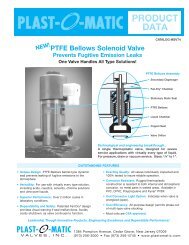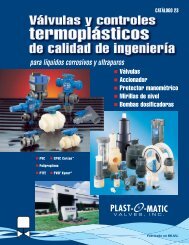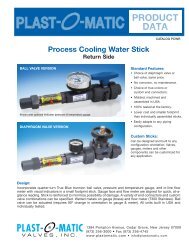Series TRVDT PTFE diaphragm 3-way relief valves [PDF format]
Series TRVDT PTFE diaphragm 3-way relief valves [PDF format]
Series TRVDT PTFE diaphragm 3-way relief valves [PDF format]
- No tags were found...
Create successful ePaper yourself
Turn your PDF publications into a flip-book with our unique Google optimized e-Paper software.
D. MAINTENANCEA. Seal Kits: Plast-O-matic recommends keeping a spare seal kit available forrepairs. Seal life will vary on applications due to cycles, temperatures,pressures, chemicals and concentration, Based on the application, aperiodic inspection and maintenance plan should be established. The partnumber for a seal kit is SK plus the valve part number less the material suffix.For example <strong>TRVDT</strong>050V-PV needs seal kit SK<strong>TRVDT</strong>050V.B. Changing Range of Adjustment: Range of pressure adjustment can bechanged by changing or combining springs. Unscrew the adjusting screwall the <strong>way</strong> and remove. Add or remove springs. Replace the adjusting screw.E. SPRING SLECTION CHARTPart Number Pipe Size Adjsut Range Springs<strong>TRVDT</strong>050V 1/2"5 - 50 LC135M-051 - 100 LC135M-0 & LC112J-4<strong>TRVDT</strong>075V 3/4"5 - 50 LHC162N-051 - 100 LHC112J-7& LHC162N-0<strong>TRVDT</strong>100V 1" 5 - 100 LC135M-3 & LHC234T-21384 Pompton Avenue,Cedar Grove, NJ 07009(973) 256-3000 • Fax: (973) 256-4745 • www.plastomatic.comGeon is a registered trademark of Geon Co. Kynar is a registered trademark of Elf-Atofina.©2007 Plast-O-Matic Valves, Inc. Printed in USA 02/2007ASSEMBLY, INSTALLATION ANDOPERATING INSTRUCTIONS FORTRUE BLUE ® <strong>PTFE</strong> DIAPHRAGMRELIEF VALVES <strong>TRVDT</strong>A. BEFORE INSTALLING1. <strong>Series</strong> <strong>TRVDT</strong> valve will open when the inlet pressure exceeds the set pressurewhen properly installed and used within the recommended ranges of pressure,temperature, and chemical compatibility. The ultimate determination of materialcompatibility is previous successful use in the same application. Call ourTechnical Support for in<strong>format</strong>ion about your application.Pressure and Temperature Ratings for Water*Body Material 77°F (25°C) 105°F (40°C) At Maximum TemperaturePVC 150 PSI (10 Bar) 100 PSI (7 Bar) 40 PSI @ 140°F ; 3 Bar @ 60°CPP* 100 PSI ( 7 Bar) 70 PSI (5 Bar) 25 PSI @ 180°F ; 2 Bar @ 80°CPVDF 150 PSI (10 Bar) 120 PSI (8 Bar) 30 PSI @ 280°F ; 3 Bar @ 140°C<strong>PTFE</strong> 40 PSI ( 3 Bar) 30 PSI (2 Bar) 5PSI @ 280°F ; 35KPa @ 140°C* or compatible chemical – ratings may be reduced for some applications.Typical burst pressure is 4 times rating or more.2. Minimum temperature 40°F (5°C).B. INSTALLATION1. The valve must be installed in the proper flow direction as indicated by theflow label. All orientations, horizontal and vertical, are suitable. Relief<strong>valves</strong> should be installed as close as possible to the vessel or pipe whichit is protecting.2. Caution: <strong>Series</strong> <strong>TRVDT</strong> is not a “pop safety” <strong>relief</strong> valve. It is not intendedfor air or gas service. It does not regulate pressure downstream of the valve.Caution: Plastic materials can degrade in ultraviolet (UV) light or sunlight.3. Visual Identification of Material:Body Material Color“PV” (Geon ® ) (PVC) Dark Gray“PP” (Polypropylene) Translucent White“PF” (Kynar ® ) (PVDF) Translucent White/Yellow“TF” (<strong>PTFE</strong>) Opaque WhiteCaution: Polypropylene and PVDF (Kynar ® ) often look similar and may bedifficult to distinguish by color. Do not install in your system if you are not sure.
4. Threaded Connections: A suitable thread sealant (ex. <strong>PTFE</strong> tape) shouldbe applied to male tapered threads to assure a “leak-tight” seal. Theassembly need only be made hand-tight followed by a quarter ( 1 /4) turn witha strap wrench. Do not over tighten or use a pipe wrench on plastic pipeand components.Caution: <strong>PTFE</strong> tape will “string” as pipe threads are joined. Loose “strings”could lay across the seating surface and prevent the valve from completelyclosing. To avoid this problem, clean out the old tape, and do not applytape to the first threads. Connections should be made only to plasticfittings; metal pipe should only be installed with an intervening plasticnipple. Metal pipe and straight threads pipe tend to cut, stretch, and distortthe plastic bodies, which could result in cracking or leaking over time.5. Non-Threaded Connections: For solvent cementing or heat fusion,contact your distributor.C. OPERATION AND SETTINGS1. Relief Valve Operation: The function of a Relief Valve is to protect apressurized pipeline, vessel, or other similar system from excessive pressure.When the inlet pressure exceeds the set point, the valve opens to bleed offthe excess pressure2. Backpressure Operation: A Backpressure Valve maintains pressure in aline or system. Excess pressure opens the valve, keeping the inlet pressureat the set point.Pressure Setting for Relief or Backpressure Valves1. Connect the valve inlet to a pressurized line which is at thedesired set point and gaged.2. Where pressurized air is used for setting, run a line from thevalve outlet into a container of water, or fill the outlet port withwater. Otherwise run a line to a drain.3. If flow is detected, turn the adjusting screw in until flow stops.4. Slowly turn the adjusting screw out until a small flow is detected.3. By-Pass Operation: A By-Pass Valve is installed in the outlet piping of apump to prevent “dead-heading” and/or control the pump’s outlet pressure.When pressure exceeds the set point, the valve opens to allow the liquid torecycle (by-pass) to the pump inlet.CEDAR GROVE, NJ 07009<strong>TRVDT</strong>075V-PVCOMMON INLETOUTLETCaution: Line pressure at the valve outlet (The pump inlet) can open thevalve, allowing reverse flow.Pressure Setting for Relief or Backpressure Valves1. Install the valve. Turn the adjusting screw all the <strong>way</strong> in.2. With the pump running normally at a pressure above the desiredpoint, turn the adjusting screw out to reach the desired pressure.D. PARTS AND ILLUSTRATION# Quantity Description Material1. 1 Body See B. 3. (page 1)2. 1 Spring Housing PVC3. 1 Lock Ring HDPE4. 1 Adjusting Screw HDPE5. 1 Diaphragm Support PVC6. 1 U-Cup Seal FKM7. 4 Hex Head Screw Stainless Steel8. 4 Lock Washer Stainless Steel9. X Springs (see table next page) Steel10. 1 Sealing Diaphragm <strong>PTFE</strong>11. 1 Backup Diaphragm FKM4AdjustingScrew3Lock Ring29Spring7,87,8FAIL FAIL-DRY DRYVENT5610Common PortOpen Open Common Port Port111By-Pass Bypass Outlet/Relief PortRelief


![Series TRVDT PTFE diaphragm 3-way relief valves [PDF format]](https://img.yumpu.com/45002261/1/500x640/series-trvdt-ptfe-diaphragm-3-way-relief-valves-pdf-format.jpg)
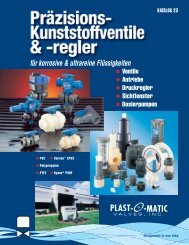
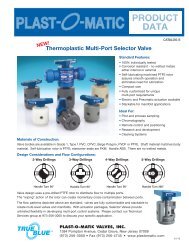
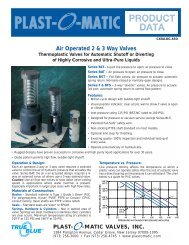
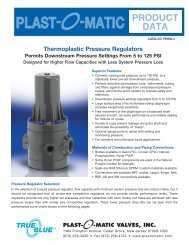

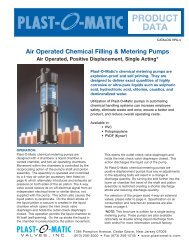
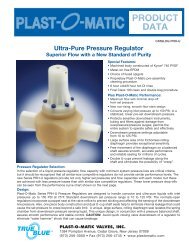

![Installation Instructions [PDF format] - Plast-O-Matic Valves, Inc](https://img.yumpu.com/35160235/1/190x245/installation-instructions-pdf-format-plast-o-matic-valves-inc.jpg?quality=85)
